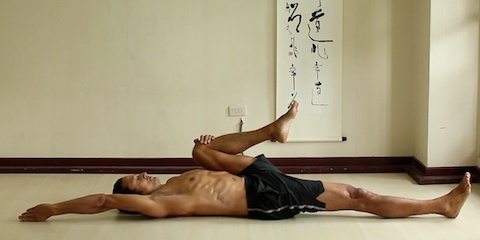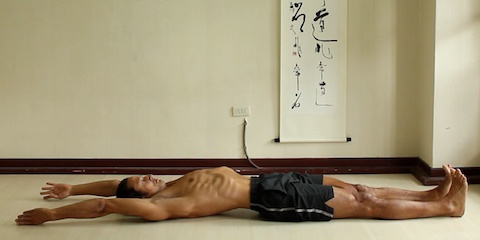Reclining psoas stretch
On page cat links

After attending a workshop with Richard Freeman I gained a new awareness of psoas major anatomy.
I also learned a reclining psoas stretch.
On page cat links

After attending a workshop with Richard Freeman I gained a new awareness of psoas major anatomy.
I also learned a reclining psoas stretch.
For the reclining psoas stretch he had us laying down on our back. Starting with both legs straight we then bent one knee and hugged it to the chest using the same-side arm. We reached the straight leg arm behind us, as if to maximize the distance between the straight leg foot and hand.
Now while reaching the leg and arm away from each other creates a lengthening affect, and can feel good, to get at the psoas major, a little more detail may be required.
We stretched the psoas major on the straight leg side by reaching the 12th (lowermost) rib away from the pelvis.
Now why bother focusing on this rib? Why not just reach the entire side of the ribcage away from the pelvis? Because there is a particular feel when you focus on the 12th rib (or the back of the kidneys.)
You are more likely to get the psoas if you focus on this rib.
That being said, when reaching with the arm, the ribs on that side will move tend to move away from the pelvis anyway. (Think of the ribs, shoulder and arm all reaching away from the pelvis.) However, what you may "feel" is the sides of the ribs reaching away from the pelvis. And even that by itself can feel nice.
However, the 12th rib is the shortest, (of the lower ribs at least). It doesn't extend into the side of the ribcage. To lift this rib (or "to pull it away from the pelvis") you have to focus on the bottom of the back of the ribcage. Or, alternatively, focus on the backs of the kidneys.
The kidneys sit in front of the 12th ribs, so using either as a reference is fine.
The bent knee is important in this pose. Hugging the knee to the chest may cause your pelvis to roll back at the same time flattening the lumbar curve. Since the psoas attaches to the lumbar spine, this flattening the lumbar spine (without allowing the straight leg thigh to lift) also has a lengthening or stretching affect on the straight leg psoas.
You could also reach both legs forwards and both arms back. You'll probably have to use your abs to help keep the lumbar curve flattened to the floor. And as you can see from the picture below, I'm not doing a very good job of that.

Previously I described this psoas stretch as starting with both legs straight.
An alternative entry, and perhaps a better one since it starts with the lumbar spine flat to the floor, is to start with both legs hugged to the chest.
Feel your lower back flattening to the floor in this position.
From here, slowly straighten one leg forwards and upwards, keeping your lumbar flat to the floor. Make the leg feel long as you slowly lower it to the floot. At the same time reach the same side arm up and then back. If you find your self lowing lower back contact with the floor, stop there, then return to the start. You may find that as you repeat this action you can slowly go deeper.
If that's too uncomfortable, then start with the legs straight. Bring one knee to the chest. Slowly hug it in. Keep the straight leg pressing into the floor (knee pointing up) and work at flattening your lumbar curve as you bring the knee to your chest. At any point you feel pain or sharp discomfort, stop. Instead of pushing through the pain, see if you can adjust your position so that you don't cause pain.
To balance psoas stretching you can work on glute stretches either before or after your reclining psoas stretch.
For more on the related anatomy (and why pulling up on the 12th rib helps) read Psoas major anatomy.
